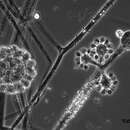en
names in breadcrumbs


Cunninghamella echinulata (C. echinulata) has globose to subglobose zygospores that are ornamented with warts, hooks, or blunt projections. The zygospore is also held by suspensor cells than can be equal or slightly unequal shown in Fig. 2. Lunn and Shipton (1983) observed rhizoid-like structures and pointed spines ornamenting the sporangiola when isolating this species, which can be observed in Fig. 1. The sporangiola are hyaline, clustered together on vesicles, and can be on branched or unbranched sporangiophores (Webster and Weber, 2007).
Fig. 1
http://i451.photobucket.com/albums/qq238/RockNRollA3/Mycology/i_zpsdbrqxnpf.png
Fig. 2
http://i451.photobucket.com/albums/qq238/RockNRollA3/Mycology/h_zps21twsgq5.png
Classification:
Fungi – Mucoromycota – Mucoromycotina – Mucorales – Cunninghamellaceae – Cunninghamella
Synonym(s):
Oedocephalum echinulate (1891) R. Thaxter
Cunninghamella echinulate (1905) R. Thaxter
Muratella elegans (1913) G. Bainier and A. Sartory
Cunninghamella verticillata (1927) F. S. Paine
Cunninghamella dalmatica (1929) P.A.Pispek
Cunninghamella echinata (1929) P. A. Pispek
Cunninghamella bainieri (1939) N.A. Naumov
Cunninghamella are found in soil, plant and animal material, and are globally dispersed among the tropics, subtropics, and temperate zones (Discovery Life, 2016).This genus of fungi can be difficult for classifying species, which is indicative of C. echinulata as it has been reclassified throughout its known existence. First described by Roland Thaxter as Oedocephalum echinulate in 1891, this fungus has a coenocytic (non-partitioned) mycelium, is areolate, and has oval, ornamented conidia (Alcorn and Yeager, 1938). One interesting feature is that apart from forming zygospores, this species can also form chlamydospores. C. echinulata can also act as mycoparasite of Rhizopus arrhizus, which is another Mucorales (Webster and Weber, 2007). Like others in Mucorales, C. echinulata is used in industry and pharmaceutical production. It contains terminal vesicles, is associated with mammalian metabolism, and can be cultivated in a lab setting (Blakeslee, 1905).
Various studies have been conducted in regard to C. echinulata’s metabolic capabilities, especially toward xenobiotic (foreign to the body) factors and drug metabolism (Smith and Rosazza, 1983). Cunninghamella, in general, are able to metabolize xenobiotics similar in processing to mammalian enzymatic systems. Furthermore, C. echinulata, as well as several other Cunninghamella species, has been researched due to various antitumor compounds arising from their ability to structurally modify organic compounds via microbial transformation (Asha and Vidyavathi, 2009).
In relatively recent years, C. echinulata has gained attention for its potential utilization in single cell oil production arising from renewable carbon sources (Fakas et al, 2009). It is an oleaginous, filamentous fungus that can accumulate triglycerides and cytosolic lipid bodies in larger amount that could result in an alternative oil source (Mukhopadhyay et al, 2011).
We report a fatal case of invasive fungal sinusitis caused by Cunninghamella echinulata in a febrile, neutropenic 15-year-old male with relapsing acute leukemia. The isolate was recovered from a nasal biopsy from the right middle meatus, and microscopic examination of the tissue revealed angioinvasion and necrosis. Human infection caused by this organism has not been well documented; however, this report alerts us to its life-threatening potential.(PubMed.gov 2013)
C. echinulata has several aspects that give it an important ecological and medical role. As mentioned earlier, this species can yield antitumor components, which could give rise to potentially very effective cancer drugs and therapeutic steroid derivatives (Betts et al, 1974). However, despite such advantages it can cause mucormycosis in patients with compromised immune systems, especially since some strains are resistant to antifungal therapies (LeBlanc et al, 2013).
Another significant aspect of C. echinulata is its potential to act as a biofuel because of its ability to produce oil from raw substrates and accumulate lipids rarely found in plants or animals. This could potentially be a starting point for bio-diesel as its oleaginous properties convert microbial oils (lipids) into bio-diesel (Fakas et al, 2009). This is important because alternative oil sources have been an ongoing conversation in leading society to environmentally friendly practices.
C. echinulata can also aid in wastewater treatment being an effective biosorbent agent. Morsy (2004) researched C. echinulata’s effectiveness in removing metal ions from polluted water, specifically in Egypt. They compared this species to other zygomycetes such as Rhizopus arrhizus, Absidia orchidis, etc. and found C. echinulata able to remove heavy metals effectively when alkali treated or when immobilized. This is significant because this could potentially improve water reuse and quality.
CulturedC. echinulata
http://i451.photobucket.com/albums/qq238/RockNRollA3/Mycology/h_zpsehezlxy7.png